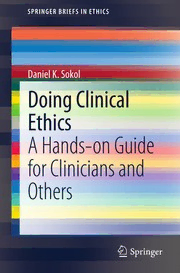
Doing Clinical Ethics [electronic resource] : A Hands-on Guide for Clinicians and Others PDF
Preview Doing Clinical Ethics [electronic resource] : A Hands-on Guide for Clinicians and Others
SpringerBriefs in Ethics For furthervolumes: http://www.springer.com/series/10184 Daniel K. Sokol Doing Clinical Ethics A Hands-on Guide for Clinicians and Others 123 Daniel K.Sokol Department of PrimaryCareand Public Health ImperialCollege London CharingCross Campus,Reynolds Building StDunstan’s Road LondonW6 8RP,UK e-mail: [email protected] URL:www.medicalethicist.net ISSN 2211-8101 e-ISSN 2211-811X ISBN 978-94-007-2782-3 e-ISBN978-94-007-2783-0 DOI 10.1007/978-94-007-2783-0 SpringerDordrechtHeidelbergLondonNewYork LibraryofCongressControlNumber:2011941665 (cid:2)TheAuthor(s)2012 Nopartofthisworkmaybereproduced,storedinaretrievalsystem,ortransmittedinanyformorby anymeans,electronic,mechanical,photocopying,microfilming,recordingorotherwise,withoutwritten permissionfromthePublisher,withtheexceptionofanymaterialsuppliedspecificallyforthepurpose ofbeingenteredandexecutedonacomputersystem,forexclusiveusebythepurchaserofthework. Printedonacid-freepaper SpringerispartofSpringerScience+BusinessMedia(www.springer.com) …an admirably short and clear guide to doing medical ethics… I welcome this book and urge medical students and doctors of all gradestoreaditinpaper,on-line,orontheir portable screen reader. From the Foreword by Sir Richard Thompson, President of the Royal College of Physicians, UK Dr. Sokol has provided the field with a much needed, easy and comprehensive tool on ‘doing’ clinical ethics that all should have in their back pockets. Dr. Nneka Mokwunye, Director of Bioethics, Washington Hospital Center, Washington DC, USA This is a magnificent guide to clinical ethics andreflects theauthor’svery wellknown and widely respected academic gravitas and real life experience in clinical ethics. It is a must read for anyone involved in the field. Mr. Vassilios Papalois, Consultant Surgeon and Chairman, Imperial College Healthcare NHS Trust Clinical Ethics Committee, UK For Sam Foreword Dr. Sokol is a senior lecturer in medical ethics who, for some years, has studied and taught the subject at Imperial College London and other institutions. As a result, he has written an admirably short and clear guide to doing medical ethics, aimed at medical students and practising clinicians. In this guide, the difficult but fundamental vocabulary of beneficence and maleficence, etc. is explained (or, in my mind, doing good and doing harm) in an effort to provide quick but reasoned answers at the coal face. Many clinicians are turned off by ethical problems, probably because they are often much less clear-cut than those of a clinical nature. As Dr. Sokol says, there areoftenseveralrightanswerstoanethicalproblem,whichiswhyheemphasises thatthisisapersonalguide.Clinicians,ontheotherhand,aretaughtnecessarilyto decidequicklyononecourseofactionthat,atagivenmoment,seemstobeinthe best interests of the patient. Perhapssomeofusarealsoputoffbythoseserious,evendeep,discussions,on andoffthemedia,ofclinicalexamples.Theseareusuallydiscussedbythoughtful (canonebetoothoughtful?)andprobablyhighlyintelligentethicists,whoseemto make difficult decisions more difficult, and soon slip into philosophy. This sits uneasily with rapid clinical decision making. Many hospitals have a standing committee available to help resolve less urgent problems but, when decisions are not straightforward, most of our advice is obtained from experienced nurses and colleagues, and from families and carers. This book is engagingly written, devoid of abstruse philosophy, and rich in practical, down-to-earth advice. There are also useful chapters on writing about medical ethics, teaching ethics, and asking for ethical permission to carry out clinical research, topics that are not usually found in textbooks. Iwelcomethisbookandurgemedicalstudentsanddoctorsofallgradestoread itinpaper,on-line,orontheirportablescreenreader.Dr.Sokoltalks aboutone’s ethical brain, or, as I see it, an ethical elf always sitting on one’s shoulder and watching. Itcanbetrainedbyconsideringproblems anddiscussingthemwiththe elves offriends and colleagues and, of course, by a careful reading of this book. ix x Foreword My only regret is that he did not digress into the ethical controversy of the day, namely assisted dying, but I hope that will be for another book! London, August 2011 Sir Richard Thompson President, Royal College of Physicians Acknowledgments IwrotemostofthisbookinAix-en-Provence,inthesouthofFrance.Mymother, a chef to rival Paul Bocuse, sustained me with sumptuous meals during the long daysatthekeyboard.Myfather,aswellasreviewingthemanuscript,draggedme onto thetennis courttopreventmuscleatrophy fromprolonged sitting. AndSam, my ever-patient wife, adopted a laid-back Provençal attitude, and cheerfully left me to my solitary work. To them all, I am grateful. OnmyreturnfromFrance,aroughdraftinhand,Iaskedfriends—perhapsnow formerfriends—tocommentonthedraft.IamindebtedtoHenryMance,aneagle- eyed journalist, for his characteristically honest suggestions, to Dr. Philip Sedgwick, statistician extraordinaire, for reviewing Chap. 4, to Richard Warry, editorattheBBCNews Online,forhistipsonsubmittingpiecestotheBBC,and to Alan Cedrik, journalist and chess master, for his helpful critique of an early draft. I am also grateful to my learned friends, Aidan O’Brien, Mathew Roper, Tom Bradfield, Susan Jones, and Leo Meredith, who displayed the kind of punctili- ousness characteristic of drafting experts. One long and memorable comment on the proper order of a question mark, a quotation mark, and a full stop ended dramatically ‘‘you have effectively fused two sentences, leading to a punctuation quandary’’.You know who you are. Countlessthanksarealsoduetothecliniciansandethicistswhotooktimefrom their busy schedules to read the book. Their suggestions have been invaluable. They are Drs. Zuzana Deans, Fauzia Paize, Hannah Peters, Francesca Rubulotta, Alifa Isaacs-Itua, Lynnette Hykin, Sabaretnam Muhundhakumar, David Hunter, Ayesha Ahmad, and James Wilson. A special note of gratitude goes to Raanan Gillon, Emeritus Professor of Medical Ethics and erstwhile supervisor of my PhD, whose influence permeates much of this book, and to Sir Richard Thompson, President of the Royal College of Physicians, who generously agreed to write the Foreword. Thanks also to Tai Sae-Eung, a talented young artist from Boston, USA, who provided the original artwork for the book, and to Meagan Curtis, from Springer, who made the whole publishing process so smooth. xi xii Acknowledgments Finally, this book would not exist were it not for the hundreds of medical students, patients, and colleagues who have taught me many of the lessons con- tained within. Thank you. All errors and omissions that remain in the text are, of course, mine alone.
